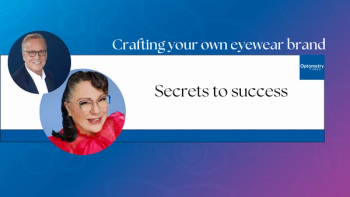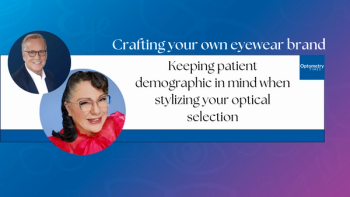
Easing the anxiety of “one or two?”
“Which is better-one or two?” This simple query, when read in sequential order, is synonymous, in part, with performing our optometric duties during an eye exam. Are you aware that for some patients, this line of questioning from the eye doctor conjures up significant anxiety?
“Which is better-one or two?” This simple query, when read in sequential order, is synonymous, in part, with performing our optometric duties during an eye exam. Are you aware that for some patients, this line of questioning from the eye doctor conjures up significant anxiety? Fasten your proverbial seat belts, dear colleagues, and get ready for a bumpy ride of reality…
Related:
The threat of spectacles
When a patient visits our optometric offices for her eye exam there can be a perceived threat about wearing spectacles. Some reports suggest those threats include concerns about possible changes to personal appearance and/or adaptation to spectacle wear.
In addition to these perceived threats, there is also a common misconception among our patients that they are in control of their final prescription. The patient thinks that if he gives the doctor an incorrect answer to the question “Which is better? One or two?” it could potentially ruin his prescription and ultimately his eyesight. The stress the patient feels if he was to answer incorrectly gives rise to the patient’s anxiety and has a negative impact on the exam.
The end result is that the patient will at times be incapable of hearing your explanation of exam results and equate his negative experience to your performance. Your competency as a doctor is being rated on this experience.
Let’s break down these perceived threats one by one.
Breaking down the threats
First, on a lesser scale, some patients may actually fear the idea that they will need to wear glasses. This can be easy to alleviate with all of the advances made in eyewear and lenses today. In addition, if a patient is really opposed to wearing spectacles, the doctor can advise the patient on options such as contact lenses or refractive surgery.
More blogs:
Next, before performing your subjective refraction, it may help to explain to your patient to know that her current prescription, the automated refraction, and subjective refraction are all used in a comprehensive exam to determine her final prescription. Offering this knowledge base should help alleviate the pressure that her responses to your line of questioning may ultimately be her undoing.
Calming patient fears
Education is the key to meeting the patient’s expectations with regard to their exam and is necessary to the patient understanding and following your prescribed treatment. Don’t wait for a patient to ask you what a “stigma” is-instead, be proactive and tackle the questions before they arise.
Educating patients on the causes of and treatments for their vision will improve their comprehension of their eye health. Handouts that explain the condition can be particularly helpful because many patients are overwhelmed at the time of a diagnosis and may want to review the information later.
I use Crystal Practice Management, which contains letter files that will print out handouts corresponding to your diagnosis along with your logo and office information nicely formatted on the top. It's as easy as two clicks of the mouse and will exemplify your verbal explanation for patient piece of mind.
Recent news:
Many patients also report being fearful of the equipment used in the exam process. The equipment often looks intimidating to the patient. A phoropter can be quite scary looking to a first-time observer. Again, a proactive explanation of the equipment’s use and functions can go a long way to ease anxiety the patient is experiencing with his exam.
For example, while pulling the phoropter in front of a patient, tell him, “This instrument contains different lenses to help measure your individual eyeglass prescription in combination to your current prescription and the reading in the automated refraction.”
Communication style and provision of written information are perhaps two of the most effective methods to manage our patient’s anxiety. Because fear is a common reason that many patients may avoid the eye doctor, ensure that your patients will keep coming back. By exploring this phenomenon and using these simple tools at your disposal, you will create a stress-free exam environment.
IMAGE: ©TYLER OLSEN/SHUTTERSTOCK.COM
Newsletter
Want more insights like this? Subscribe to Optometry Times and get clinical pearls and practice tips delivered straight to your inbox.


















































.png)


